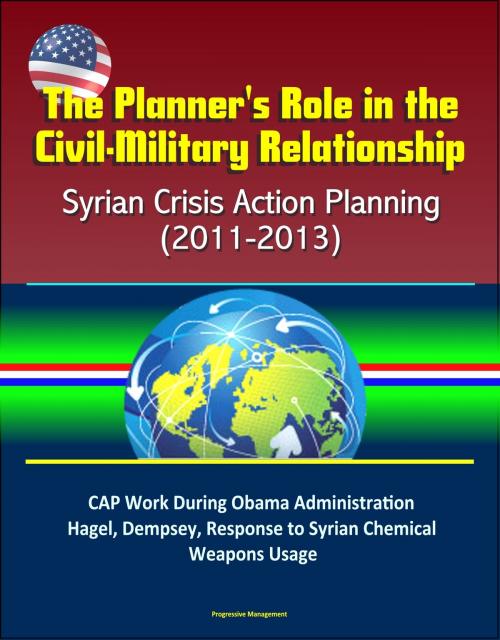The Planner's Role in the Civil-Military Relationship: Syrian Crisis Action Planning (2011-2013) - CAP Work During Obama Administration, Hagel, Dempsey, Response to Syrian Chemical Weapons Usage
Nonfiction, History, Middle East, Military, United States| Author: | Progressive Management | ISBN: | 9781370102648 |
| Publisher: | Progressive Management | Publication: | February 22, 2017 |
| Imprint: | Smashwords Edition | Language: | English |
| Author: | Progressive Management |
| ISBN: | 9781370102648 |
| Publisher: | Progressive Management |
| Publication: | February 22, 2017 |
| Imprint: | Smashwords Edition |
| Language: | English |
This excellent report has been professionally converted for accurate flowing-text e-book format reproduction. Crisis action planning (CAP) is the military process for resolving imminent and emerging crises. CAP activities require the interaction and collaboration of numerous echelons to provide military and whole-of-government options to the National Command Authority for consideration. The interactions of CAP directly test and influence the nature of US civil-military relations.
Syrian CAP from 2011-2013 presents a contemporary case for study. Analysis of the case reveals the relationship that military planners and commanders have with developing and implementing policy options while engaging in civil-military relations. As the conflict simmered and became more volatile, the US government expended increasing energy to understand the environment and problem while searching for solutions. The planning efforts evolved over time, and, as dialogue improved, organizations overcame bureaucracy to build consensus. Throughout the period, evaluations of options never resulted in military intervention. Instead, the US government applied instruments of national power in discrete ways for limited ends focused on symptoms of the conflict. This monograph concludes that the essential activities for military planners and leadership to support crisis planning include cultivating appropriate authorities and relationships, clarifying roles and expectations, assimilating strategic and regional contexts, and creating shared understanding of the character of the conflict.
The crisis in Syria began for US planners almost immediately upon initiation of armed hostilities between the Bashar al-Assad regime and the Syrian population. The crisis in Syria and Iraq as of this writing is an evolving one. Being that US and allied involvement in planning for this crisis is ongoing, the plans and formal documents detailing these efforts are, and will likely remain, classified for the near future. However, the interaction between the Secretaries of Defense and State, the CJCS, and Congress establishes an open, unclassified window into the requirements of civil-military dialogue and contemporary, if unclassified, options provided to senior civilian leadership. Additionally, these public interactions serve as milestones to frame CAP efforts.
Following the initiation of the Syrian armed conflict in March 2011, the USCENTCOM, the Joint Staff (JS), and the Office of the Secretary of Defense (OSD) began the process of CAP pursuant to guidance from the National Security Council System. Over the following two years, hostilities escalated to include the Syrian government's purported use of chemical weapons in April of 2013. Addressing this conflict required a collaboration between these organizations to generate options for consideration by the NCA. These planning efforts culminated with the public disclosure of five military options by the CJCS, General Martin Dempsey, in a series of letters and testimony to Congress from July through September 2013.
This excellent report has been professionally converted for accurate flowing-text e-book format reproduction. Crisis action planning (CAP) is the military process for resolving imminent and emerging crises. CAP activities require the interaction and collaboration of numerous echelons to provide military and whole-of-government options to the National Command Authority for consideration. The interactions of CAP directly test and influence the nature of US civil-military relations.
Syrian CAP from 2011-2013 presents a contemporary case for study. Analysis of the case reveals the relationship that military planners and commanders have with developing and implementing policy options while engaging in civil-military relations. As the conflict simmered and became more volatile, the US government expended increasing energy to understand the environment and problem while searching for solutions. The planning efforts evolved over time, and, as dialogue improved, organizations overcame bureaucracy to build consensus. Throughout the period, evaluations of options never resulted in military intervention. Instead, the US government applied instruments of national power in discrete ways for limited ends focused on symptoms of the conflict. This monograph concludes that the essential activities for military planners and leadership to support crisis planning include cultivating appropriate authorities and relationships, clarifying roles and expectations, assimilating strategic and regional contexts, and creating shared understanding of the character of the conflict.
The crisis in Syria began for US planners almost immediately upon initiation of armed hostilities between the Bashar al-Assad regime and the Syrian population. The crisis in Syria and Iraq as of this writing is an evolving one. Being that US and allied involvement in planning for this crisis is ongoing, the plans and formal documents detailing these efforts are, and will likely remain, classified for the near future. However, the interaction between the Secretaries of Defense and State, the CJCS, and Congress establishes an open, unclassified window into the requirements of civil-military dialogue and contemporary, if unclassified, options provided to senior civilian leadership. Additionally, these public interactions serve as milestones to frame CAP efforts.
Following the initiation of the Syrian armed conflict in March 2011, the USCENTCOM, the Joint Staff (JS), and the Office of the Secretary of Defense (OSD) began the process of CAP pursuant to guidance from the National Security Council System. Over the following two years, hostilities escalated to include the Syrian government's purported use of chemical weapons in April of 2013. Addressing this conflict required a collaboration between these organizations to generate options for consideration by the NCA. These planning efforts culminated with the public disclosure of five military options by the CJCS, General Martin Dempsey, in a series of letters and testimony to Congress from July through September 2013.















